Just watching the Trump Not State Of The Union. Do you think Americans understand what a bunch of thick twats they come across as when they chant ‘USA USA USA’?
Just watching the Trump Not State Of The Union. Do you think Americans understand what a bunch of thick twats they come across as when they chant ‘USA USA USA’?
Trump planned the ambush to make up ground with his base after he was nice to other foreigners earlier in the week, but the angle of attack was a straightforward narcissistic rant because Zelensky wasn’t being grateful enough to placate the big fragile orange ego.
For at least the last 25 years, since I read Neal Stephenson’s Cryptonomicon, I’ve flirted with Linux every so often, and it’s so much better now than it was. I think Apple’s pricing and Windows' cruft and AI might be making it time to move.
My latest flirt is with the Linux partition of my Chromebook, partly for sheer tinkering, and also because there’s a specific notes app which is best in Linux, and also ChromeOS’s file management app is execrable and even a lightweight Linux file manager is vital. But as ever, Linux has thrown weirdness at me, and it’s taken a few hours of trawling Reddit to sort out. Wider web searches are pointless even on DuckDuckGo, because useful results have been ratio’d to homeopathic proportions by AI slop.
I simply wanted to have the notes app appear in the Chromebook launcher in a folder called Linux, which is what normally happens with Linux stuff installed via the commandline. But I’d had to use AppImage (another learning point) and it didn’t happen here. With a Chrome app, or even a web app converted to its own container with a couple of clicks in Chrome, it would be a matter of selecting something from a context menu. Linux, more complicated.
But I still will probably move at some point.
Firstly, cost. My computing needs are modest, apart from occasional video editing and I have a lowend Mac Mini which is fine for that. Everything else is basically browsing and writing. I’m fine with whatever 10 year old ThinkPad I can get for a couple of hundred bucks, in terms of hardware.
Secondly, the operating system. Windows sounds more and more of a crufty nightmare, aimed at feeding Redmond’s AI beasts more than doing what users want, and demanding ever higher specs in the process. Macs are lovely but stupidly overpriced. My Chromebook is great but I trust Google less and less.
It’s a big contrast though, between the slickness of ChromeOS, in which I am the product to be sold to marketers, and where my content is used to train AIs, vs the stroppy, awkward independence of open source.
But in the end, the geeky 14 year old who spent his computer science lessons learning what hexadecimal codes to ‘poke’ down the school network to make rude words appear on his mate’s BBC B computer lives on.
I’ve been using a Chromebook as my main computer for months now, and for almost everything, it’s a great laptop.
Almost everything. The one thing it lacks is halfway usable file management. The ChromeOS file manager is like using a particularly clunky website from 2009 which needs to sync to the server every time it as much as breathes. Trying to organise my files has been agony.
Then, in a belated flash of inspiration, I realised the solution, and now I have a file manager that works as well or better than Windows file explorer and Mac’s Finder.
(You can scroll down a bit for the actionable stuff. I will overlook your rudeness).
Why does file organisation matter? Doesn’t ‘search’ do everything we need now?
Maybe. But for an old fart like me. I like to have my stuff logically filed in folders, because that’s what I learned in the 80s when I first started using computers. I don’t trust searching, entirely, and more importantly, duplicates proliferate if you’re not careful, and when you’re collaborating on a document it’s easy to miss someone else’s changes and comments. And clients don’t like that.
So here’s the way to avoid that on a Chromebook.
Here’s the TLDR: newish Chromebooks make it easy to use Linux apps, so I installed a Linux file manager. Specifically, Nemo. Voila, I have have proper file manager.
If that’s the info you need, have at it. Go and install Nemo, and may you and your descendants prosper.
If that sounds scary but you still want a decent file manager, let me walk you through it.
The tiny (I promise) downside here is having to tangle minimally with Linux’s command line terminal - a charmingly retro way of typing apparently gibberish into the laptop so you look like a hacker in a film. When I say minimally, I mean copying and pasting a couple of lines of terminal commands from this post. Which is very minimal.
Here we go:
…If you haven’t already. Open up Settings and typ ‘Linux’ in the search box. You’ll get the settings page related to Linux things. (Ignore the orange 4 and 5 on this screenshot).
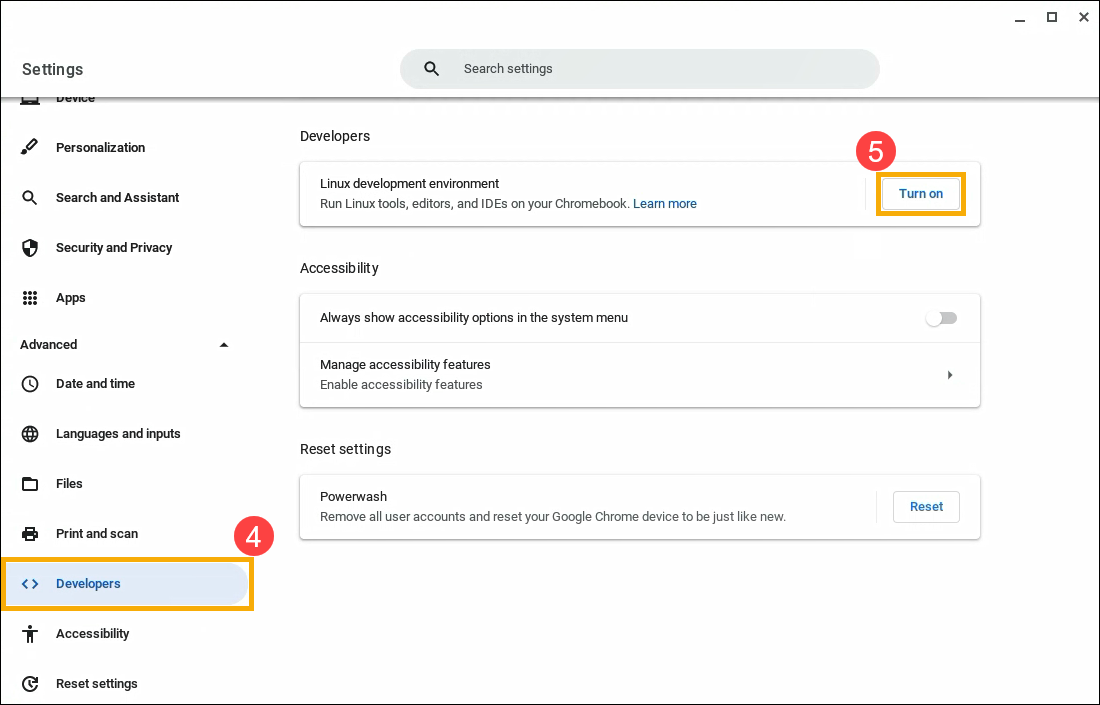
Pick the bottom option to Enable Linux development environment. It just means your Chromebook will be part Linux now. You’ll need to give it a bit of hard drive to use. Four gigs will be more than enough for our purposes and shouldn’t affect ChromeOS
Without going Full Linux, there’s no shiny pretty app like the Play store, or App store etc. to find and install programmes (or as Linux calls them, ‘packages’) from. The ‘store’ does exist, though it’s called a repository. In the absence of a shiny app store, you have to use text commands in the Terminal to install programmes.
You get to the Terminal by hitting the Everything key and typing ‘Terminal’ then clicking on the icon.
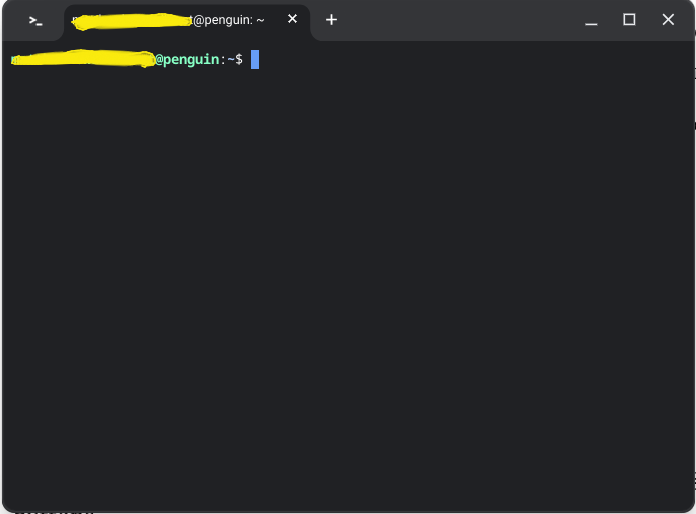 (The yellow scrawls are obscuring my Google ID. You should have your ID in their place)
(The yellow scrawls are obscuring my Google ID. You should have your ID in their place)
They look impenetrable, but they’re just the equivalent of clicking ‘get’ or ‘install’ buttons. sudo apt install nemo
The internet is riddled with people who are far better equipped than I am to explain Linux command lines, so I encourage googling. However, in painfully simplistic terms:
SUDO - tells the Chromebook you have the right to install things (NB Linux heads: yes, I know it’s not quite that simple. But it will do for our purposes for the moment).
APT - tells it you want to install, update or remove a package
INSTALL - shockingly, this instructs the system you’re choosing the install option
NEMO - … and this is what you want it to install
Anyway, copy and paste those four words into the Terminal. You’ll get a rather cinematic scrolling commentary of what the Chromebook’s doing, stopping when it asks you whether you want to go ahead.
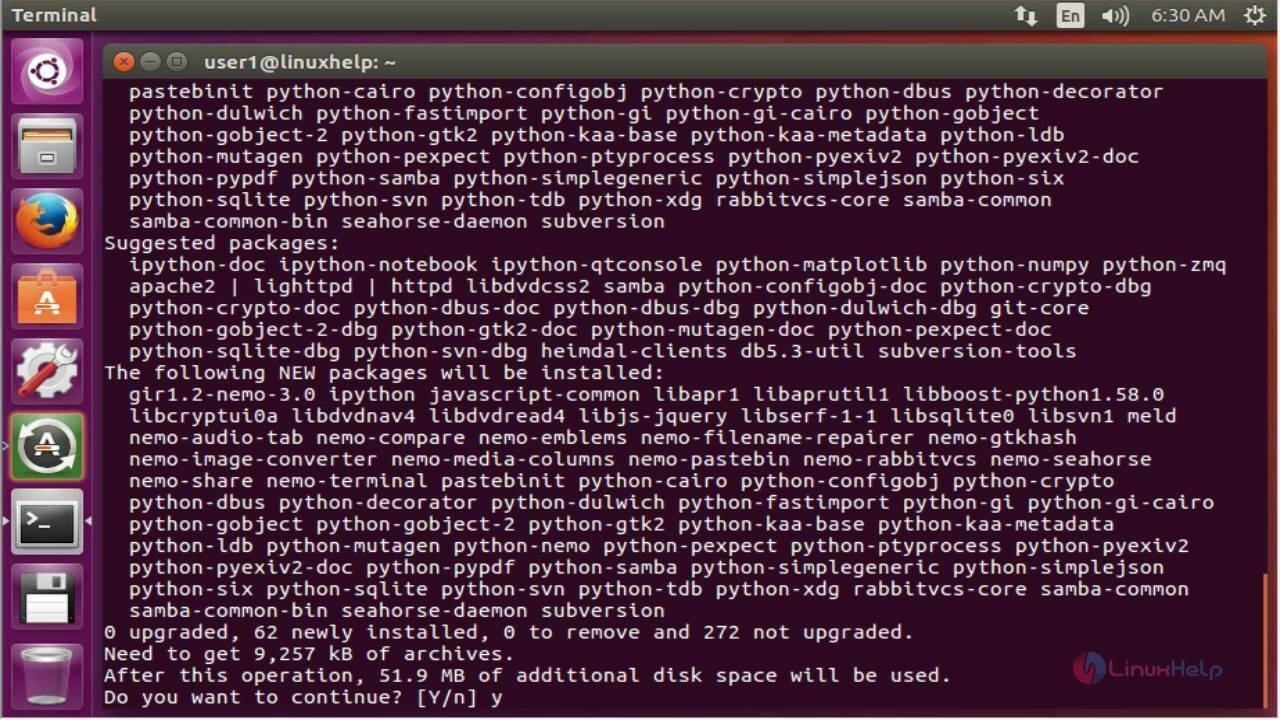
Thrillingly, like a 1980s BBC Micro text adventure, you can type ‘Y’ and hit return to go ahead.
There will be more cinematic scrolling and when it’s done, you’ll be back to the prompt.
This concludes your adventure with the Linux command line. You can return triumphantly to your ChromeOS village now you’ve accomplished your mission and vanquished the forces of darkness.
Most easily done by hitting the ‘Everything’ key and searching for Nemo. Sometimes it’s called ‘Files’. Either way, it’ll be represented by a little penguin icon, which you can click on. Assuming all’s well, you’ll now get a very recognisable file manager window, something like this.
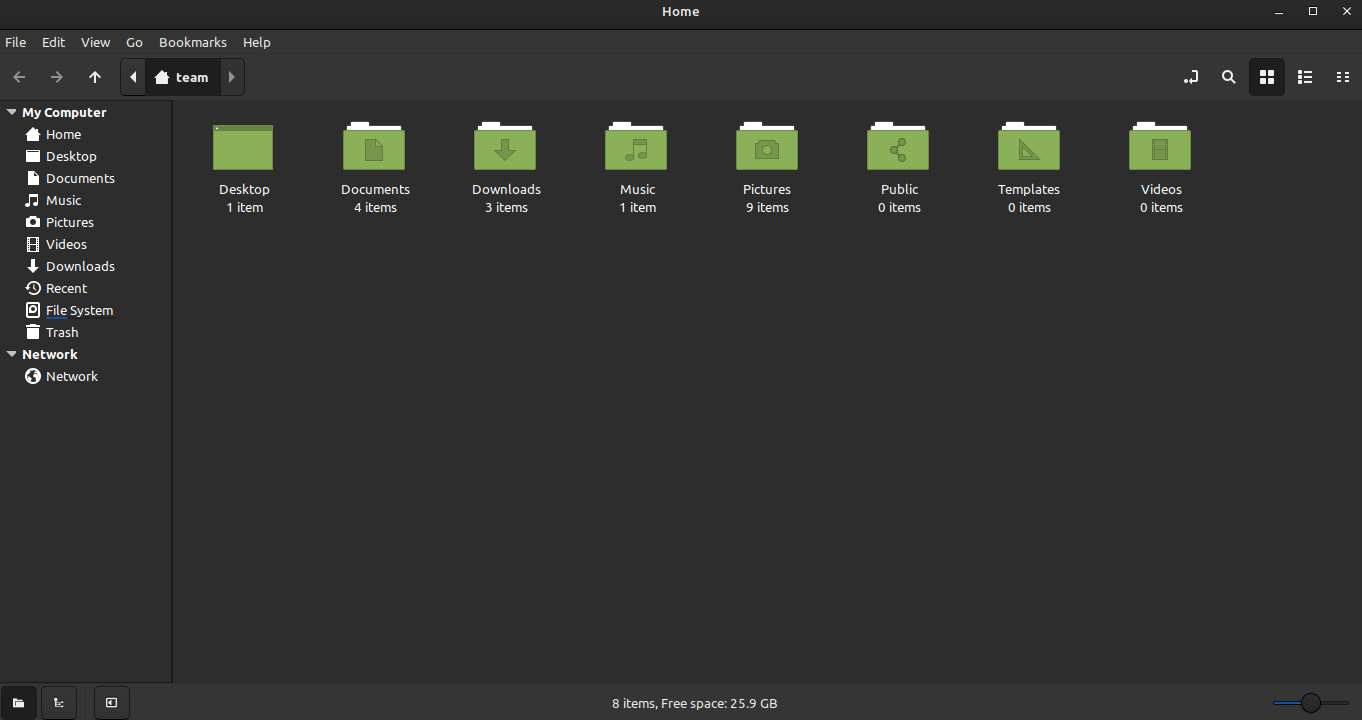
The icon will also be in your ‘shelf’, so you can pin it in the usual way for future use.
Since the lack of a proper file manager has bothered you enough to get this far, I’m assuming you can figure it out yourself, mostly.
IMPORTANT FACTS TO PREVENT LOSS OF ALL YOUR FILES
However, given you’re using Linux and you’re on a Chromebook, a couple of things to bear in mind.
The main one being:
YOUR FILES ARE IN /mnt/chromeos/.
LEAVE EVERYTHING ELSE ALONE UNLESS YOU KNOW WHAT YOU’RE DOING.
There will be two folders (aka directories): MyFiles and GoogleDrive. MyFiles (/mnt/chromeos/MyFiles)
MyFiles is part of the Linux system. MyFiles isn’t synced anywhere, it’s just on your hard drive.
GoogleDrive (/mnt/chromeos/GoogleDrive/MyDrive)
This is where your Google Drive files are. It’s a mirror of your Google Drive, which you will already be using as part of normal Chromebook operations.
However.
If you’re clicking into that folder now, you may have noticed it’s not showing any of your Google Drive files. Do not panic.
This is what you need to do.
One last time, you will need to return to the ChromeOS file manager. Think of it as closure so you can move on. You need to make custody arrangements for your files.
You need to tell ChromeOS to let Linux see its files and folders.
You do this by right-clicking on the folder or file and choosing ‘Manage Linux Sharing’, and turning it on. Whatever you do will apply to that folder and everything it contains.
You might have to close and re-open Nemo at this point so it registers it can now see the files. On the other hand, you might not.
The back in your Nemo, for your own sanity, I suggest right-clicking on your most used folders and choosing ‘favourite’ so they appear in the box of favourite places in the left of the Nemo window and you don’t have to traverse through your folders all the time.
That’s pretty much it.
One last thing: I’m not a Linux head. If you want to know more about it, I suggest googling and also reddit.com/r/linux4noobies. I’ve mostly used the excellent instructions on Chromeunboxed However, it was written a few years ago, before Chromebooks made using Linux so easy, so a lot of the stuff about permissions doesn’t apply any more.
Enjoy endless fiddling about with your files but slightly more conveniently.
Snotty upmarket opticians: no sir, that loose hinge on your glasses is irreparable. You will need a new pair. Walmart opticians: give me five minutes, I’ll glue it, no charge.
I’m spending far too much time recently figuring out my best options for writing apps across a bunch of platforms, and having finally been forced to tabulate my findings for my own benefit, though I might as well stick them as a blogpost.
Table below, for the impatient, but for the more patient, some context:
I’m mostly Apple-based (iPhone, iPad, Mac Mini) but for the next few months a lot of my writing and other work type things will be on a Chromebook, for various reasons. (Old basic iPad with a Logitech keyboard just about scrapes by as an emergency pseudo-laptop, but only just).
Getting a Macbook would make compatibility a lot simpler but I can’t really justify one when a Chromebook does everything I need for a quarter of the price, if I can live with some minor complications.
I have no strong views about OSes/open sourceness/proprietary software, but Windows seems to be going through an awful phase at the moment, so I’d rather avoid it. Similarly, I’m a bit cautious about anything corporate American because who knows what’s going to happen there. I’m not fanatically anxious about AI, but it would be nice to avoid being scraped and intruded on if I can.
I’m generally able to get online but I want to be able to be able to work offline if necessary.
So I looked at what my options were, and these are them. Obviously there are other criteria but these are the important ones to me. Judgements are subjective, of course.
In the unlikely event anyone reads this, I’d welcome your thoughts.

TIL that Google Keep doesn’t have a way to add photos from Google Photos. Image files from your drives, yes. Photos Google already knows about, not so much.
When I log into iCloud in Chrome I get a weird serif font in Reminders. On the other iCloud account, same browser, literally logging out of one account and into another, I get the right design. I’ve cleared the cache, logged in and out, and the wrong font has persisted for months. Thoughts?
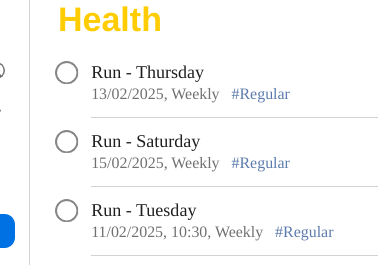
I find I’m filtering all the coverage of the US through my ‘what would the Germany-in-1933 version of that be?’ touchstone to gauge implications.
Disturbed to find Martin from Friday Night Dinner as a murderous baddie in the very bad final Da Vinci Code film. He has yet to say ‘shit on it’ and his shirt remains on, however.
Most journalists (some of my best friends etc.) want to get the story right, but they need your help. Find out what you can do in this close analysis of me getting the wrong end of the stick over a story this week. truesciencestories.substack.com/p/how-to-…
Most journalists (some of my best friends etc.) want to get the story right, but they need your help. Find out what you can do in this close analysis of me getting the wrong end of the stick over a story this week. truesciencestories.substack.com/p/how-to-…
A planned post for my True Science Stories substack about how a study got covered in the media didn’t turn out how I expected. Always good to figure out when you’re wrong why you got it wrong.
Full confession in tomorrow’s newsletter.
I think humanity is safe from AI for the moment. I just had to beat Google’s Gemini into submission after it had come up with four erroneous ‘solutions’ to a thing I wanted to do on Substack before admitting it couldn’t be done. It’s like dealing with a toddler who’s just discovered lying.
Just heard Fi Glover on Times Radio being immensely dense about a study saying banning phones in school doesn’t materially affect educational benefits. However much the lead researcher patiently explained the point was that school use made little difference because most use is out of school, Glover was determined that the take away was that phone use overall makes no difference.
I double checked the story quickly on the BBC (https://www.bbc.co.uk/news/articles/cy8plvqv60lo) and it seems this is the obtuse line across the media more widely.
I’ll dig into more in my newsletter this week and explain how these things happen.
Trump trying to outsource taxation and make other countries pay for the US via tariffs is a kind of analogy for how he wants likes to manage his narcissistic emotions, by forcing other people to make him feel good inside.
A dudebro behind me in this café, having grown weary of praising Trump oh-so-ironically, is now explaining to a fellow dudebro how Kraftwerk invented synthesisers.

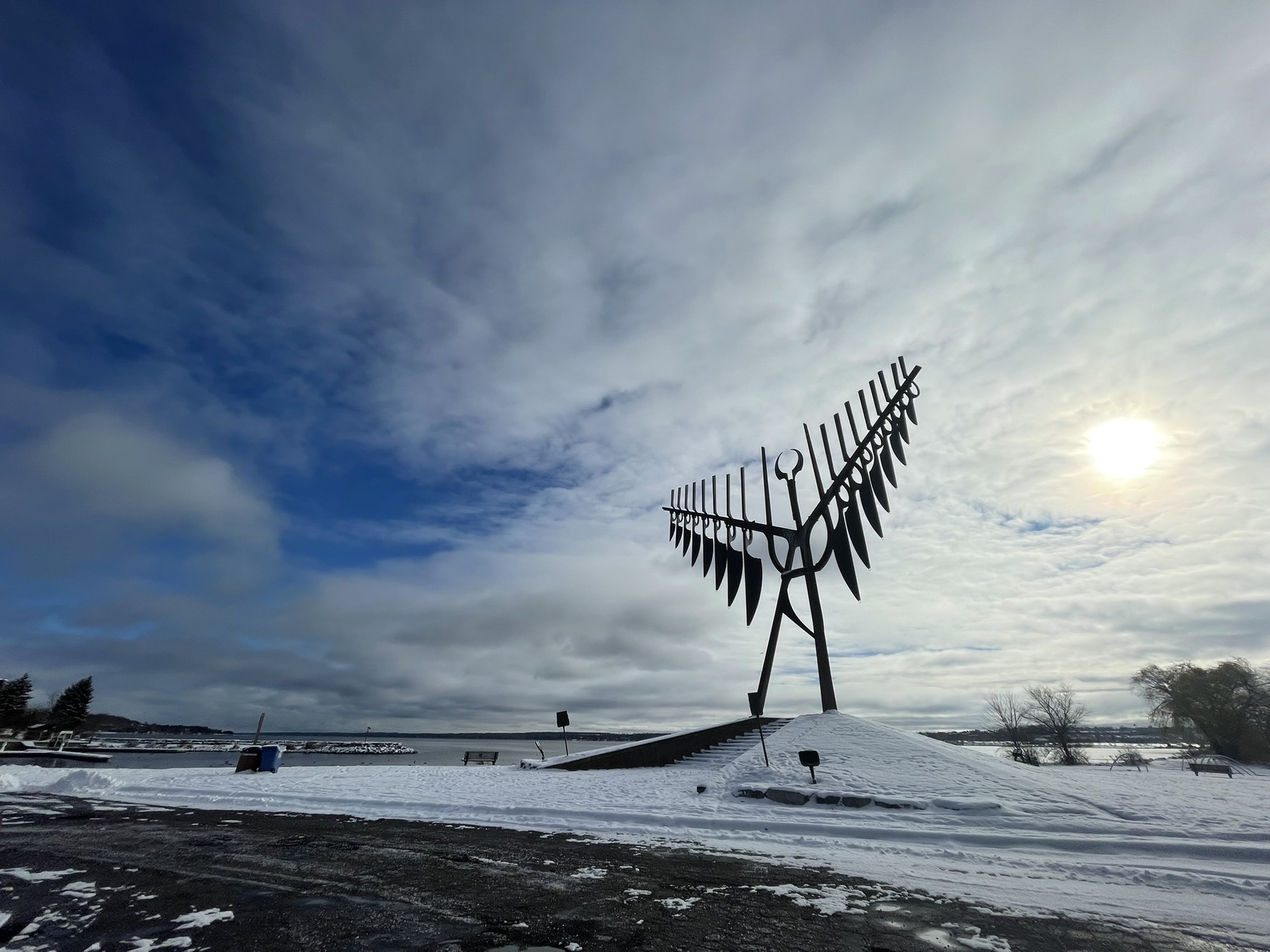

I asked it to collate contact names from public websites like LinkedIn and employee profile pages. But it can’t use that dataset. It can make up researchers, departments and institutions and only admit it when you point this out.
I’m only getting scared of AI when it stops recommending I buy a Very Expensive Thing because I just bought an identical one.
When you realise that of your five Substack readers, one is yourself, another is your ex wife keeping tabs, and another is a bot. The other two are old clients.
Reading through some old journal entries about the whys and hows of my writing. I’d come a long way when I wrote them nearly three years ago, and I’ve come further now. I needed the healthy, supportive relationship I have now and also, I’m realising, the time and distance I’m getting by moving to Canada.
When accidentally leaving your laptop at home reminds you that sometimes scrawling stuff into an actual physical paper notebook hits a vein of way better ideas.
Oscillating between anxiety about paying bills (unwarranted because I can afford them) and reassuring myself that Big New Plans are panning out as I wanted, just slowly. Which I also expected.
Today I found out that Canada could’ve joined the nukes club at the start of the Cold War but chose not to, unlike the UK, which should’ve made the same decision.
As a Brit in Canada, this whole Trump Tariffs insanity is sounding very much like Brexit - the triumph of deluded bigotry over the mutual benefits of trade and compromise.